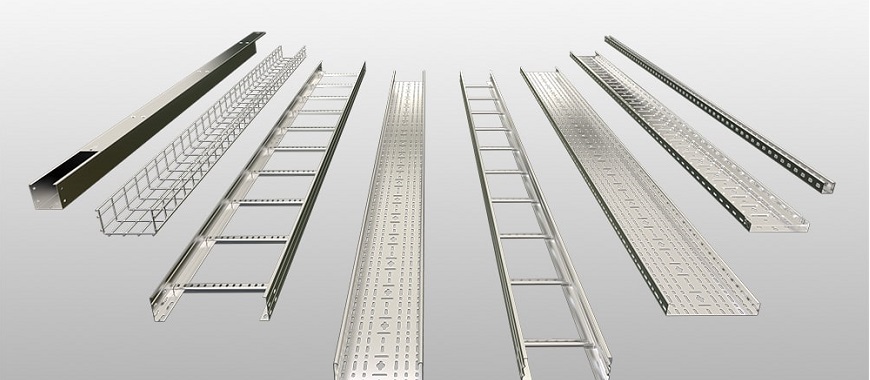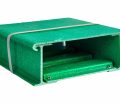
When determining how many cables fit in a tray, proper sizing is crucial to ensure safety and efficiency. Following industry standards like the NEC guidelines helps maintain optimal fill ratios. For example, a conduit allows a fill ratio of 53% for one cable, 31% for two cables, and 40% for three or more cables. Applying these principles to cable trays ensures adequate space for heat dissipation and reduces risks of cable damage. Practical application involves calculating the combined diameter of cables and comparing it to the tray’s available cross-sectional area. Understanding how many cables fit in a tray not only simplifies installation but also ensures future-proofing by allowing space for additional cables while maintaining system performance.
The Key of How Many Cables Fit in a Tray
Determining how many cables fit in a tray is essential for effective cable management. This process involves considering tray size, cable dimensions, and spacing requirements to ensure safety and performance. Below, we delve into critical factors, guidelines, and best practices related to this topic.
Factors Influencing How Many Cables Fit in a Tray
The number of cables that can fit in a tray depends on various factors. These factors help in planning and optimizing the tray’s capacity while maintaining operational efficiency.
- Cable Size and Type:
The diameter and insulation of the cables significantly impact their fit within the tray. Larger cables require more space, limiting the total count. - Tray Dimensions:
Tray width, depth, and length dictate the available space for cable placement. Wider trays can accommodate more cables. - Separation Requirements:
Certain applications require physical separation between cables to prevent interference, which affects the tray’s capacity. - Bend Radius:
Maintaining the proper bend radius for each cable type ensures functionality and reduces the risk of damage. - Fill Ratio Guidelines:
Industry standards, such as NEC recommendations, specify fill ratios to avoid overloading trays and to promote airflow.
Benefits of Calculating How Many Cables Fit in a Tray
Understanding how many cables fit in a tray offers several advantages for cable management and overall system performance.
- Efficient Space Utilization:
Proper calculation ensures that the tray’s capacity is used optimally without exceeding its limitations. - Improved Safety:
Avoiding overcrowding reduces the risk of overheating, short circuits, and physical damage to the cables. - Simplified Maintenance:
Organized cables are easier to access for inspections and repairs, minimizing downtime. - Cost Savings:
Efficient planning reduces the need for additional trays or corrective measures, saving time and resources. - Regulatory Compliance:
Adhering to capacity guidelines ensures that installations meet industry safety standards.
Methods for Determining How Many Cables Fit in a Tray
There are several methods to calculate how many cables fit in a tray effectively. These approaches combine measurements, standards, and tools for accurate results.
- Using Cable Cross-Sectional Area:
Measuring the cross-sectional area of each cable and comparing it to the tray’s total capacity helps determine the maximum fit. - Applying Fill Ratio Standards:
Industry standards specify recommended fill ratios based on tray type and application, guiding the placement of cables. - Utilizing Software Tools:
Digital calculators and design software simplify the process, offering precise capacity estimations. - Consulting Manufacturer Specifications:
Tray manufacturers often provide detailed capacity charts and guidelines for their products. - Conducting Field Measurements:
On-site measurements and test layouts verify the accuracy of calculations and the feasibility of planned installations.
Applications of Knowing How Many Cables Fit in a Tray
Understanding cable tray capacity is critical across various industries, ensuring efficient and reliable installations. Common applications include:
- Data Centers:
Managing high volumes of data cables requires precise capacity planning to prevent overcrowding and maintain system performance. - Industrial Facilities:
Performance depends on ensuring that power and control cables fit securely within trays, especially in heavy-duty environments. - Commercial Buildings:
Electrical and network cabling in offices and retail spaces benefits from well-organized tray systems. - Renewable Energy Projects:
Solar and wind installations rely on accurate tray capacity calculations to support large-scale electrical cabling. - Transportation Hubs:
Cable trays in airports and train stations require proper planning to manage communication and power systems efficiently.
Best Practices for Ensuring Cables Fit Properly in a Tray
Proper planning and execution are key to ensuring cables fit securely and safely in a tray. Following these best practices can improve outcomes:
- Adhere to Fill Ratios:
Always maintain the recommended fill ratios to allow for airflow and avoid overcrowding. - Group Cables by Function:
Separate cables based on their function to minimize interference and simplify troubleshooting. - Plan for Future Growth:
Leave extra space for additional cables to accommodate future expansions or modifications. - Secure Cables Properly:
Use ties, clamps, or brackets to keep cables in place and prevent movement within the tray. - Inspect Regularly:
Periodic inspections ensure that trays remain within capacity limits and that cables are in good condition.
How GangLong Fiberglass Ensures Accurate Cable Tray Capacity
At GangLong Fiberglass, we provide tailored solutions to help clients determine how many cables fit in a tray effectively. Our approach includes:
- Custom Tray Designs:
We offer trays in various dimensions and configurations, allowing clients to choose options that best fit their needs. - Detailed Specifications:
Our trays come with comprehensive capacity charts and installation guidelines for accurate planning. - Technical Support:
Our team provides expert advice and tools to calculate tray capacity and ensure safe installations. - High-Quality Materials:
Made from FRP, our trays combine strength and lightweight properties to support extensive cabling systems. - Sustainable Solutions:
GangLong Fiberglass prioritizes eco-friendly manufacturing processes while delivering reliable cable tray products.
Common Challenges When Calculating How Many Cables Fit in a Tray
Accurate capacity planning requires addressing potential challenges that may arise during calculations or installations. These challenges include:
- Inconsistent Cable Sizes:
Variations in cable diameters can complicate capacity estimations, requiring precise measurements. - Unpredictable Future Needs:
Planning for future cable additions without exceeding tray limits demands careful foresight. - Environmental Constraints:
Harsh conditions, such as extreme temperatures or corrosive environments, may affect tray material and capacity. - Regulatory Requirements:
Navigating complex industry standards and codes requires expertise and attention to detail. - Installation Errors:
Misalignments or improper securing of cables can reduce tray efficiency and safety.
Innovations in Cable Tray Design for Optimal Capacity
Modern advancements in cable tray design have made it easier to calculate and optimize capacity. Notable innovations include:
- Modular Systems:
Modular tray components enable flexible configurations, accommodating various cable sizes and layouts. - Smart Monitoring:
Integrated sensors monitor tray usage and provide real-time data on capacity and performance. - Lightweight Materials:
Advanced materials, such as FRP, allow for higher load capacities without increasing tray weight. - Custom Fabrication:
Tailored tray designs cater to specific project requirements, maximizing space utilization. - Enhanced Ventilation:
Improved tray designs promote airflow, reducing the risk of overheating and cable damage.
Knowing how many cables fit in a tray is fundamental for successful installations. GangLong Fiberglass provides solutions that combine precision, reliability, and sustainability, ensuring clients achieve optimal results in their cable management projects.
How About Determining How Many Cables Fit in a Tray?
Planning cable installations effectively begins with determining how many cables fit in a tray. This ensures efficient cable management, safety, and compliance with industry standards. Below, we explore key factors, best practices, and solutions to accurately calculate cable tray capacity.
Factors That Affect How Many Cables Fit in a Tray
Several factors influence the number of cables that can fit in a tray. Understanding these factors is crucial for achieving an efficient and safe installation.
- Cable Dimensions:
The diameter and insulation thickness of cables significantly impact their fit. Larger cables require more space, reducing the total number that a tray can accommodate. - Tray Size and Design:
The width, depth, and length of the tray determine the available space for cable placement. Different tray designs, such as ladder or perforated, may affect capacity. - Spacing Requirements:
Physical separation between cables is often necessary to prevent overheating or signal interference, reducing the usable tray space. - Fill Ratio Guidelines:
Industry codes and standards, such as those from the NEC, recommend specific fill ratios to ensure cables remain organized and safe within trays. - Bend Radius Constraints:
Cables must be installed with a minimum bend radius to maintain their integrity, which can influence how many cables fit in a tray.
Cable Tray Radius: Understanding and Its Applications
Benefits of Knowing How Many Cables Fit in a Tray
Accurately determining cable tray capacity offers several benefits, ensuring optimal functionality and safety for the system.
- Efficient Space Management:
Proper calculations ensure that the tray is used to its full potential without overcrowding or underutilization. - Reduced Safety Risks:
Preventing overcrowding minimizes hazards such as overheating, physical damage to cables, or short circuits. - Improved Maintenance Access:
Organized cables are easier to identify and access during inspections or repairs, reducing downtime. - Cost-Effective Installations:
Accurate capacity planning minimizes the need for additional trays or modifications, saving time and resources. - Enhanced Performance:
Maintaining adequate spacing and airflow around cables ensures their longevity and reliability.
How to Calculate How Many Cables Fit in a Tray
Accurate calculations require a combination of measurements, tools, and adherence to standards. Below are common methods for determining how many cables fit in a tray.
- Using Cable Dimensions and Tray Size:
Calculate the total cross-sectional area of all cables and compare it to the tray’s capacity. Ensure that the total area does not exceed the recommended fill ratio. - Referring to Manufacturer Specifications:
At GangLong Fiberglass, we provide detailed capacity charts and guidelines for our trays, making it easy to determine their maximum capacity. - Utilizing Design Software:
Digital tools and calculators simplify the process by considering factors such as cable size, spacing, and tray dimensions. - Applying Fill Ratios:
Standards such as NEC recommend specific percentages of tray space that should be occupied by cables, ensuring sufficient room for airflow and maintenance. - Conducting Field Tests:
Trial layouts can help verify calculations and provide a clearer picture of how many cables will fit in the tray.
Best Practices for Maximizing Cable Tray Capacity
Adhering to best practices ensures that cable trays are used efficiently and remain compliant with safety standards.
- Group Similar Cables:
Organize cables by type or function to simplify maintenance and reduce the risk of interference. - Secure Cables Properly:
Use clamps or ties to prevent movement and ensure that cables remain in place within the tray. - Plan for Future Growth:
Leave additional space in the tray for potential future installations, reducing the need for new trays. - Maintain Adequate Spacing:
Follow spacing guidelines to prevent overheating and ensure easy access during maintenance. - Inspect Regularly:
Periodic checks help identify potential issues such as overcrowding or damaged cables, ensuring the system operates efficiently.
Top Cable Tray Products for Efficient Cable Management
Applications That Require Knowing How Many Cables Fit in a Tray
Determining how many cables fit in a tray is vital across various applications, helping to maintain order and functionality.
- Data Centers:
Performance relies on managing high-density data cables without overcrowding, ensuring signal integrity and proper cooling. - Industrial Facilities:
Power and control systems benefit from accurate capacity planning, which supports operational efficiency and safety. - Commercial Spaces:
Offices and retail buildings require organized network and power cabling for streamlined operations. - Renewable Energy Projects:
Solar and wind installations demand precise tray capacity calculations to manage extensive electrical cabling securely. - Transportation Hubs:
Airports and railway systems rely on well-managed cable trays to support communication and power systems efficiently.
Challenges in Determining How Many Cables Fit in a Tray
Several challenges may arise when calculating cable tray capacity. Identifying and addressing these challenges ensures successful installations.
- Variability in Cable Sizes:
Differences in cable dimensions can complicate calculations, requiring precise measurements for accuracy. - Future Expansion Needs:
Accommodating potential future cables while staying within capacity limits requires careful planning. - Environmental Factors:
Conditions such as temperature, humidity, and exposure to chemicals can affect the tray’s material and capacity. - Compliance with Standards:
Navigating complex codes and regulations requires expertise to ensure the system meets safety requirements. - Installation Errors:
Incorrectly placed cables or misaligned trays can reduce efficiency and compromise safety.
Innovations Supporting Cable Tray Capacity Calculations
Advancements in technology have introduced tools and designs that simplify determining how many cables fit in a tray.
- Modular Tray Systems:
Modular designs allow flexible configurations, enabling better utilization of available space. - Smart Monitoring Technology:
Sensors integrated into trays can track capacity usage and alert users to potential issues in real-time. - Enhanced Materials:
At GangLong Fiberglass, we use lightweight, durable FRP materials that support extensive cabling systems without compromising capacity. - Digital Calculation Tools:
Software solutions provide detailed capacity estimates based on cable size, tray dimensions, and environmental conditions. - Custom Fabrication Options:
Tailored trays designed to specific project requirements optimize space utilization and ensure efficient installations.
How GangLong Fiberglass Supports Accurate Capacity Planning
At GangLong Fiberglass, we specialize in providing high-quality cable trays and expert guidance to help clients determine how many cables fit in a tray.
- Custom Designs:
Our trays are tailored to fit specific project needs, ensuring compatibility with various cable types and layouts. - Detailed Specifications:
We provide comprehensive guidelines and capacity charts with every tray, simplifying the planning process. - Technical Expertise:
Our team offers support throughout the installation process, ensuring accurate capacity planning and compliance. - Sustainable Manufacturing:
We prioritize environmentally friendly materials and processes without compromising quality or performance. - Innovative Solutions:
Our products include advanced features such as modularity and lightweight materials to enhance efficiency.
Knowing how many cables fit in a tray is essential for successful installations. GangLong Fiberglass offers the expertise, tools, and high-quality products needed to achieve optimal results in any cable management project.
Understanding Cable Tray Finishes and Their Applications
FAQs about How Many Cables Fit in A Tray
The number of cables that can fit in a cable tray depends on several factors, such as the tray’s dimensions, the diameter of the cables, and the allowable fill capacity. To determine the exact number:
Measure the cross-sectional area of the tray.
Calculate the total cross-sectional area of all the cables you plan to install.
Ensure the sum of the cable areas does not exceed the tray’s allowable fill rate, typically 50% for power cables and up to 70% for communication cables, as recommended by standards like the NEC.
For example, in a tray with a width of 300mm and height of 100mm, you would first calculate the tray’s area (300 x 100 = 30,000mm²) and then determine the combined area of the cables. Keep a margin for ventilation and future additions.
The maximum fill capacity of a cable tray is defined by the standards to ensure safety and efficiency. Generally:
For power cables, the fill capacity is typically limited to 50% of the tray’s cross-sectional area to allow for adequate heat dissipation.
For communication or low-voltage cables, the fill capacity can go up to 70%, as these cables generate less heat.
Overfilling can cause overheating, mechanical damage, and difficulty during maintenance or future upgrades.
Adhering to these guidelines ensures proper cable management, maintains system performance, and prolongs the lifespan of both the cables and the tray.
Proper cable placement in a cable tray is essential for safety, organization, and performance. Follow these guidelines:
Group similar cables together: Keep power, communication, and control cables in separate sections to avoid electromagnetic interference (EMI).
Maintain spacing: Ensure adequate spacing between cables to allow for heat dissipation.
Secure cables as needed: Use straps or clamps to prevent cables from shifting or sagging, especially in vertical trays.
Avoid crossing: Lay cables parallel and avoid unnecessary overlaps, which can cause physical damage or interference.
Follow bend radius: When cables change direction, ensure the bending radius meets the manufacturer’s specifications to prevent stress on the cables.
Organized placement improves maintenance efficiency and reduces the risk of operational issues.

As the editor of GangLong Fiberglass, I have years of experience and in-depth research, focusing on cable tray products, fiberglass solutions, and grille systems. I incorporate years of industry insights and practical experience into every content, committed to promoting the progress of the industry. At GangLong Fiberglass, my commitment is reflected in every product, from innovative cable trays to durable fiberglass solutions and sturdy grille systems. As an authoritative voice in the industry, my goal is to provide valuable information to professionals and businesses and promote forward-looking solutions.


